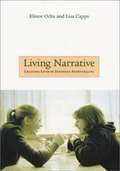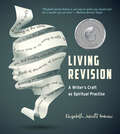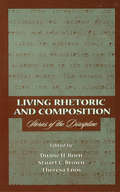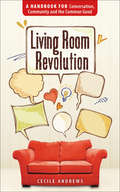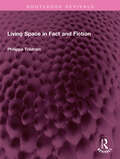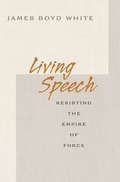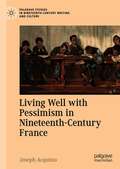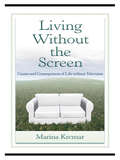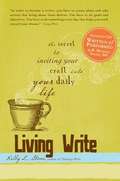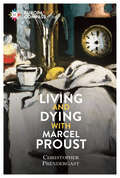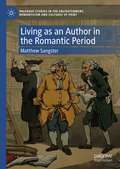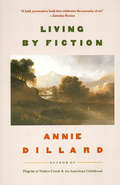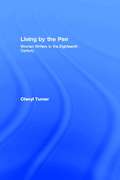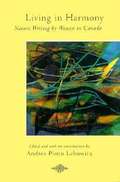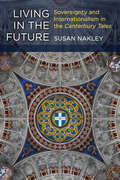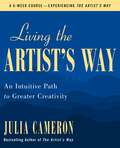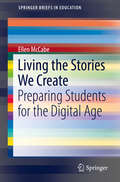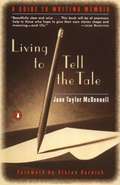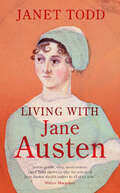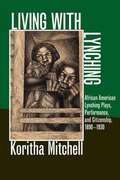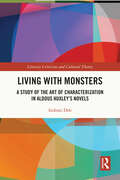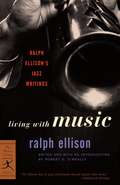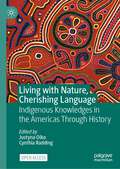- Table View
- List View
Living Narrative: Creating Lives In Everyday Storytelling
by Elinor Ochs Lisa CappsThis work looks at everyday storytelling as a twofold phenomenon - a response to our desire for coherence, but also to our need to probe and acknowledge the enigmatic aspects of experience. Letting us listen in on dinner-table conversation, prayer, and gossip, Elinor Ochs and Lisa Capps develop a way of understanding the seemingly contradictory nature of everyday narrative - as a genre that is not necessarily homogeneous and as an activity that is not always consistent but consistently serves our need to create selves and communities. Focusing on the ways in which narrative is co-constructed, and on the variety of moral stances embodied in conversation, the authors draw out the instructive inconsistencies of these collaborative narratives, whose contents and ordering are subject to dispute, flux, and discovery. In an eloquent last chapter, written as Capps was waging her final battle with cancer, they turn to "unfinished narratives," those stories that will never have a comprehensible end.
Living Revision: A Writer's Craft as Spiritual Practice
by Elizabeth Jarrett Andrew“Revision is the spiritual practice of transformation—of seeing text, and therefore the world, with new eyes. Done well, revision returns us to our original love.” In Living Revision, award-winning author and teacher Elizabeth Jarrett Andrew guides writers through the writing and revision process. With insight and grace, Andrew asks writers to flex their spiritual muscles, helping them to transform their writing as they in turn transform into more curious and reflective human beings. Her expertly honed techniques, exercises, and personal examples will help writers invigorate their work and themselves as they engage the human heart within and across the page. Living Revision is no mere guide with tips and tricks—although it does have those—but a deep and reflective well for writers to draw from as they strengthen their relationship to the creative source.
Living Rhetoric and Composition: Stories of the Discipline
by Stuart C. Brown Theresa Enos Duane H. RoenThis collection--of the stories of scholars who have found a lifelong commitment to the teaching of writing--includes the professional histories of 19 rhetoricians and compositionists who explain how they came to fall in love with the written word and with teaching. Their stories are filled with personal anecdotes--some funny, some touching, some m
Living Room Revolution: A Handbook for Conversation, Community and the Common Good
by Cecile AndrewsThe author of The Circle of Simplicity “joyfully invites us to discover a robust and real personal expansion with each other as we remake our society” (Mark Lakeman, cofounder, The City Repair Project).Every man for himself! For too long we have lived in a competitive, consumer-oriented culture, destroying the well-being of people and the planet. We believe that money brings happiness, yet all too often, the opposite is true. The pursuit of wealth at any cost corrupts our values and diminishes our lives. The resulting inequality breaks down social cohesion and generates envy, bitterness, and resentment. Greed breeds more greed.Living Room Revolution refutes the notion that selfishness is at the root of human nature. Research shows that people—given the right circumstances—can be caring, nurturing and collaborative. Presented with the opportunity, they gravitate toward actions and policies embodying empathy, fairness, and trust instead of competition, fear, and greed. The regeneration of social ties and the sense of caring and purpose that comes from creating community drive this essential transformation.At the heart of this movement is the ancient art of conversation. Living Room Revolution provides a practical toolkit of concrete strategies to facilitate personal and social change by bringing people together in community and conversation.The heart of happiness is joining with others in good talk and laughter. Each person can make a difference, and it can all start in your own living room!“Small groups. Study circles. Stop ’n chats. House parties. Movie nights. Online sharing. Bring people together, and you never know what kind of fuse you’ll ignite for change.” —Wanda Urbanska, author of The Heart of Simple Living
Living Space in Fact and Fiction (Routledge Revivals)
by Philippa TristramFirst published in 1989, Living Space in Fact and Fiction explores the house both in the ‘real’ world of the architect and the built environment, and in the fictional world of the novelist. The role of the house, in fact and fiction, tells us much about the space we live in, while the work of contemporary architects and designers illuminates aspects of the novelist’s art. Profusely illustrated, Living Space takes the history of the house from the Georgian world of Samuel Richardson’s Pamela through the works of novelists such as Jane Austen, Dickens, George Eliot, and Henry James, up to 1914, when the notion of the house changes its nature. Philippa Tristram is concerned not only with the structure and organization of the house, but with the inner life lived within it. She shows how the subconscious life of the family was transformed over a century and a half, revealed in the shape and structure of the home. This book will be of interest to students of literature, history and architecture.
Living Speech: Resisting the Empire of Force
by James Boyd WhiteLanguage is our key to imagining the world, others, and ourselves. Yet sometimes our ways of talking dehumanize others and trivialize human experience. In war other people are imagined as enemies to be killed. The language of race objectifies those it touches, and propaganda disables democracy. Advertising reduces us to consumers, and clichés destroy the life of the imagination. How are we to assert our humanity and that of others against the forces in the culture and in our own minds that would deny it? What kind of speech should the First Amendment protect? How should judges and justices themselves speak? These questions animate James Boyd White's Living Speech, a profound examination of the ethics of human expression--in the law and in the rest of life. Drawing on examples from an unusual range of sources--judicial opinions, children's essays, literature, politics, and the speech-out-of-silence of Quaker worship--White offers a fascinating analysis of the force of our languages. Reminding us that every moment of speech is an occasion for gaining control of what we say and who we are, he shows us that we must practice the art of resisting the forces of inhumanity built into our habits of speech and thought if we are to become more capable of love and justice--in both law and life.
Living Well with Pessimism in Nineteenth-Century France (Palgrave Studies in Nineteenth-Century Writing and Culture)
by Joseph AcquistoThis book traces the emergence of modern pessimism in nineteenth-century France and examines its aesthetic, epistemological, ethical, and political implications. It explores how, since pessimism as a worldview is not empirically verifiable, writers on pessimism shift the discussion to verisimilitude, opening up rich territory for cross-fertilization between philosophy and literature. The book traces debates on pessimism in the nineteenth century among French nonfiction writers who either lauded its promotion of compassion or condemned it for being a sick and unliveable attempt at renunciation. It then examines the way novelists and poets take up and transform these questions by portraying characters in lived situations that serve as testing grounds for the merits or limitations of pessimism. The debate on pessimism that emerged in the nineteenth century is still very much with us, and this book offers an interhistorical argument for embracing pessimism as a way of living well in the world, aesthetically, ethically, and politically.
Living Without the Screen: Causes and Consequences of Life without Television
by Marina KrcmarLiving Without the Screen provides an in-depth study of those American families and individuals who opt not to watch television, exploring the reasons behind their choices, discussing their beliefs about television, and examining the current role of television in the American family. Author Marina Krcmar answers several questions in the volume: What is television? Who are those people who reject it? What are their reasons for doing so? How do they believe their lives are different because of this choice? What impact does this choice have on media research? This volume provides a current, distinctive, and important look at how personal choices on media use are made, and how these choices reflect more broadly on media’s place in today’s society. A compelling exploration of the motivations and rationales for those who choose to live without television, this book is a must-read for scholars and researchers working in children and media, media literacy, sociology, family studies and related areas. It will also be of interest to anyone with questions about media usage and the choices families make regarding the role of media in their lives.
Living Write
by Kelly L StoneLiving Write is a state of mind!By using a mix of anecdotal material from writers who have been there and a series of progressive and creative psychological exercises, professional counselor Kelly L. Stone shows you how to: Make writing a daily priorityMaintain enthusiasm, motivation, and dedication for your long-term writing goalsOvercome your fear of failure and gain confidence in your writing abilitiesIdentify yourself as a "writer" instead of someone who casually sits down to writeEach interactive exercise serves as a mental workout and helps you train your brain for writing success. You'll find a comprehensive program to reverse negative writing habits and move forward as a goal-oriented writer.This book also includes an instructive CD so you can put the techniques described in the book into practice right away--and make writing something you look forward to as much as your morning coffee!
Living Write
by Kelly L. StoneSPECIAL SHRINKWRAPPED BUNDLE! WithThe Living and Thinking Write Bundle with CD, you will learn effective tips and techniques to defeat creative roadblocks and maximize your writing sessions in order to achieve your goals. Counselor and author Kelly L. Stone reveals proven techniques to banish negativity and harness the power of your subconscious mind. Living Writereveals day-to-day techniques from writers who have overcome excuses, as well as a series of time-tested psychological exercises to help you maintain enthusiasm, gain confidence in your abilities, and make writing a daily habit. Once you have conquered all writing roadblocks,Thinking Writediscusses proven techniques you can use to release the prolific writer within and write your best work. Both titles contain instructive CDs to help you put these techniques into practice and start writing your best work now!
Living and Dying with Marcel Proust
by Christopher PrendergastA New York Times Editors’ Choice A Publisher’s Weekly Most Anticipated Book of 2022 Living and Dying with Marcel Proust is the result of a lifetime’s reading of, reflection on, and love for Proust’s masterpiece, In Search of Lost Time. One of the masterpieces of twentieth-century fiction, Proust’s In Search of Lost Time describes a unique journey, combining elements drawn from the timeless narratives of great expectations and lost illusions. In this lively and entertaining book, Christopher Prendergast traces that journey as it unfolds on an arc defined by the polarities in his title: living and dying. At once a careful contemplation Proust’s masterwork and an exploration of the rich sensory and impressionistic tapestry of a lived world, Living and Dying with Marcel Proust addresses such disparate Proustian obsessions as insomnia, food, digestion, color, addiction, memory, breath and breathing, breasts, snobbism, music, and humor. Entertaining and erudite, Prendergast’s book will surely become the companion for all readers either about to reembark on Proust’s three-million-word journey or setting out for the first time. “Splendid... Reading [it] feels like, say, seeing all of Venice in a gondola, seated beside a patient, smiling, all-knowing art historian.”—Edmund White, The New York Times Book Review
Living as an Author in the Romantic Period (Palgrave Studies in the Enlightenment, Romanticism and Cultures of Print)
by Matthew SangsterThis book explores how authors profited from their writings in the late eighteenth and early nineteenth centuries, contending that the most tangible benefits were social, rather than financial or aesthetic. It examines authors’ interactions with publishers; the challenges of literary sociability; the vexed construction of enduring careers; the factors that prevented most aspiring writers (particularly the less privileged) from accruing significant rewards; the rhetorical professionalisation of periodicals; and the manners in which emerging paradigms and technologies catalysed a belated transformation in how literary writing was consumed and perceived.
Living by Fiction
by Annie DillardLiving by Fiction is written for--and dedicated to--people who love literature. Dealing with writers such as Nabokov, Barth, Coover, Pynchon, Borges, García Márquez, Beckett, and Calvino, Annie Dillard shows why fiction matters and how it can reveal more of the modern world and modern thinking than all the academic sciences combined. Like Joyce Cary's Art and Reality, this is a book by a writer on the issues raised by the art of literature. Readers of Pilgrim at Tinker Creek and Holy the Firm will recognize Dillard's vivid writing, her humor, and the lively way in which she tackles the urgent questions of meaning in experience itself.
Living by the Pen: Women Writers in the Eighteenth Century
by Cheryl TurnerLiving by the Pen traces the pattern of the development of women's fiction from 1696 to 1796 and offers an interpretation of its distinctive features. It focuses upon the writers rather than their works, and identifies professional novelists. Through examination of the extra-literary context, and particularly the publishing market, the book asks why and how women earned a living by the pen. Cheryl Turner has researched and lectured widely in the field of eighteenth-century women's writing.
Living in Harmony: Nature Writing by Women in Canada
by Andrea Pinto Lebowitz20 Canadian women write about Origins, Explorations, Home, Encounters, Place, Gardens, For the Future, and On the Form.
Living in the Future: Sovereignty and Internationalism in the Canterbury Tales
by Susan NakleyNationalism, like medieval romance literature, recasts history as a mythologized and seamless image of reality. Living in the Future analyzes how the anachronistic nationalist fantasies in Geoffrey Chaucer’s Canterbury Tales create a false sense of England’s historical continuity that in turn legitimized contemporary political ambitions. This book spells out the legacy of the Tales that still resonates throughout English literature, exploring the idea of England in the medieval literary imagination as well as critiquing more recent centuries’ conceptions of Chaucer’s nationalism. Chaucer uses two extant national ideals, sovereignty and domesticity, to introduce the concept of an English nation into the contemporary popular imagination and reinvent an idealized England as a hallowed homeland. For nationalist thinkers, sovereignty governs communities with linguistic, historical, cultural, and religious affinities. Chaucerian sovereignty appears primarily in romantic and household contexts that function as microcosms of the nation, reflecting a pseudo-familial love between sovereign and subjects and relying on a sense of shared ownership and judgment. This notion also has deep affinities with popular and political theories flourishing throughout Europe. Chaucer’s internationalism, matched with his artistic use of the vernacular and skillful distortions of both time and space, frames a discrete sovereign English nation within its diverse interconnected world. As it opens up significant new points of resonance between postcolonial theories and medieval ideas of nationhood, Living in the Future marks an important contribution to medieval literary studies. It will be essential for scholars of Middle English literature, literary history, literary political and postcolonial theory, and literary transnationalism.
Living the Artist's Way: An Intuitive Path to Greater Creativity
by Julia CameronDiscover the revolutionary new Artist’s Way tool, from "the Queen of Change" (New York Times)In her internationally bestselling book, The Artist’s Way, Julia Cameron shared with her millions of readers the three main tools needed to unlock creativity. Now, in her revolutionary new book, Living the Artist’s Way, Cameron finally reveals the vital fourth Artist’s Way tool that she relies upon daily to find creative inspiration: writing for guidance.Over the course of six weeks, readers learn the radical new skill needed to take their creativity and their creative work to the next level: how to connect with the intuitive power within themselves and trust the answers they receive. For followers of the Artist’s Way program and newcomers alike, this exciting new guidebook will teach readers how to find greater happiness, productivity, and creative inspiration.
Living the Stories We Create: Preparing Students for the Digital Age (SpringerBriefs in Education)
by Ellen McCabeThis work explores the potential of digital media to rectify the disparity between formal learning contexts and contemporary perceptions and expectations of narrative. How can education systems respond to the changing technological landscape, thus preparing students to become active participants in society as well as to realise the extent of their own potential? This book explores such concepts in the classroom environment through direct engagement with students and teachers with the case of Shakespeare's Macbeth. Written in approximately 1606, Macbeth has its roots in a culture of orality and yet has sustained through centuries of print dominance. Indeed, as both text and performance the work itself embodies both the literary and the oral. Yet as a staple of many second level curricula increasingly Macbeth is perceived as an educational text. Macbeth reflects its cultural moment, an age of ambiguity where much like today notions of selfhood, privacy, societal structures, media and economy were being called into question. Thus Macbeth can be understood as a microcosm of the challenges existing in contemporary education in both content and form. This book examines Macbeth as a case-study in seeking to explore the implications of digital media for learning, as well as its possible potential to constructively facilitate in realigning formal learning contexts to contemporary experiences of narrative.
Living to Tell the Tale
by Jane Taylor McdonnellMcDonnell draws from her own experiences as a writer and a teacher of memoirs to provide the definitive book on writing "crisis memoirs"
Living with Jane Austen
by Janet ToddFanny Price, in Mansfield Park, tells her persistent suitor that 'we have all a better guide in ourselves...than any other person can be'. Sometimes, however, we crave external guidance: and when this happens we could do worse than seek it in Jane Austen's own subtle novels. Written to coincide with Austen's 250th birthday, this approachable and intimate work shows why and how - for over half a century - Austen has inspired and challenged its author through different phases of her life. Part personal memoir, part expert interaction with all the letters, manuscripts and published novels, Janet Todd's book reveals what living with Jane Austen has meant to her and what it might also mean to others. Todd celebrates the undimmable power of Austen's work to help us understand our own bodies and our environment, and teach us about patience, humour, beauty and the meaning of home.
Living with Lynching: African American Lynching Plays, Performance, and Citizenship, 1890-1930
by Koritha MitchellLiving with Lynching: African American Lynching Plays, Performance, and Citizenship, 1890-1930 demonstrates that popular lynching plays were mechanisms through which African American communities survived actual and photographic mob violence. Often available in periodicals, lynching plays were read aloud or acted out by black church members, schoolchildren, and families. Koritha Mitchell shows that African Americans performed and read the scripts in community settings to certify to each other that lynch victims were not the isolated brutes that dominant discourses made them out to be. Instead, the play scripts often described victims as honorable heads of household being torn from model domestic units by white violence. In closely analyzing the political and spiritual uses of black theatre during the Progressive Era, Mitchell demonstrates that audiences were shown affective ties in black families, a subject often erased in mainstream images of African Americans. Examining lynching plays as archival texts that embody and reflect broad networks of sociocultural activism and exchange in the lives of black Americans, Mitchell finds that audiences were rehearsing and improvising new ways of enduring in the face of widespread racial terrorism. Images of the black soldier, lawyer, mother, and wife helped readers assure each other that they were upstanding individuals who deserved the right to participate in national culture and politics. These powerful community coping efforts helped African Americans band together and withstand the nation's rejection of them as viable citizens.
Living with Monsters: A Study of the Art of Characterization in Aldous Huxley’s Novels (Literary Criticism and Cultural Theory)
by Indrani DebAldous Huxley is one of the most well-known modernist intellectuals of the first half of the twentieth century, excelling in novels, essays, philosophical tracts, and poems. His novels are special in that they use a unique form – the novel of ideas – with which to satirize human nature and the pride regarding human achievement. Few readers of English literature are not acquainted with books like Point Counter Point, Eyeless in Gaza and Brave New World (novels dealt with in detail). A proper study of Huxley’s characterization in his novels opens up a veritable treasure-house of history, philosophy, psychology, and incisive satire. "Characterology", as the art of projecting different kinds of characters is called, is an ancient art, which either aimed at representing the entire universe in a single individual, or the same in a variegated form through various individuals. Huxley uses the latter kind in his representation of character, and as such, a study of the characters of his novels opens up a general interpretation of the universe as a whole.
Living with Music: Ralph Ellison's Jazz Writings
by Ralph EllisonBefore Ralph Ellison became one of America’s greatest writers, he was a musician and a student of jazz, writing widely on his favorite music for more than fifty years. Now, jazz authority Robert O’Meally has collected the very best of Ellison’s inspired, exuberant jazz writings in this unique anthology.
Living with Nature, Cherishing Language: Indigenous Knowledges in the Americas Through History
by Cynthia Radding Justyna OlkoThis open access book explores the deep connections between environment, language, and cultural integrity, with a focus on Indigenous peoples from early modern times to the present. It illustrates the close integration of nature and culture through historical processes of environmental change in North, Central, and South America and the nurturing of local knowledge through ancestral languages and oral traditions. This volume fills a unique space by bringing together the issues of environment, language and cultural integrity in Latin American historical and cultural spheres. It explores the reciprocal and necessary relations between language/culture and environment; how they can lead to sustainable practices; how environmental knowledge and sustainable practices toward the environment are reflected in local languages, local sources and local socio-cultural practices. The book combines interdisciplinary methods and initiates a dialogue among scientifically trained scholars and local communities to compare their perspectives on well-being in remote and recent historical periods and it will be of interest to students and scholars in fields including sociolinguistics, (ethno)history, linguistic anthropology, cultural studies and cultural anthropology, environmental studies and Indigenous/minority studies.
